
Two sides
Who do editors think they are talking to when they put their newspapers together? People with the same world view? People in power? People they think know nothing and will just take whatever they are served as gospel?
Over the next month, a million people are expected to go on strike. About 3% of the country’s workforce. Not a huge proportion, then, but enough to cause significant disruption, as we’ve seen in recent weeks. They include rail workers, postal workers, Border Force staff, ambulance drivers, paramedics, driving examiners, bus drivers, baggage handlers and, of course, nurses. Then there are teachers and junior doctors, who are also talking about taking action, and barristers, who already have. Quite a cross-section of society.
To judge by the tone of the coverage of their disputes, you’d suppose that none of these workers reads the Sun or the Mail or the Telegraph, and that, even if they do, none of them has a mind of their own.
They are being manipulated by ‘union barons’ who are holding the country to ransom, with Mick Lynch of the RMT the ultimate pantomime villain (the RCN’s Pat Cullen just isn’t cut out for such a role). It’s as though the people on the picket lines, the people going without pay, are just the union chiefs’ playthings, not people who actually voted to take this action to make themselves heard.
As I’ve said a thousand times before, it’s one thing for newspapers to take a view on policies, events, issues. But they should at least report them first. How about a cut-out-and-keep guide to who’s going on strike and why, bald facts, put in context? What? Are you mad? Much better to publish he-said, she-said knockabout, hand over space to the relevant government ministers to put their case, and denounce these greedy, heartless union leaders for causing misery – and at Christmas to boot.

How is it that the government can’t get involved in pay negotiations with nurses, who are public employees, ‘because it would undermine the independent review body’; yet it can scupper a deal between the rail companies and their staff – who are not public employees? Why are our most popular newspapers not asking these questions? Because it’s much easier to pick your side and run a front page attacking the strikers and their representatives – like this one from the Sun – without pausing to think that those strikers might be the very people you are trying to sell your paper to.
And remember it wasn’t only the nurses and ambulance workers that they were clapping every Thursday five minutes ago. Bus drivers and teachers and doctors and, yes, rail workers were all ‘key workers’ we were busy thanking during the pandemic.
How quickly we forget. Shortly before Covid struck, Tory MPs were cheering a vote not to give nurses a pay rise. Health staff had to take the hit to their pockets. Then they had to go into the danger zone with inadequate PPE purchased via ministers’ friends at extortionate prices. And when they emerged and said, ‘we did what you asked, now pay us properly please’, they were told ‘your demands are unaffordable. They will send prices rocketing.'
It’s very uncomfortable. Especially as the evidence is that, for all the delays to treatment, the public remains firmly behind the nurses and the ambulance crews. They may get fed up with the people disrupting their holiday travel arrangements, but there is not the antagonism towards the other strikers that, say, the Mail might imagine.
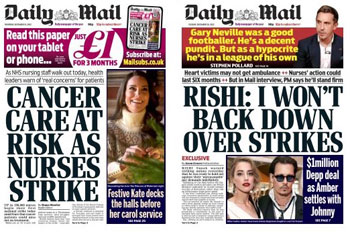
Yesterday, it ran a leader saying that what ‘sticks in the craw’ about the ambulance workers’ ‘excessive demands’ is that their basic pay, excluding ‘lucrative’ overtime, has risen since 2010, unlike that of the nurses or many in the private sector.
That’s half right. In real terms, ambulance workers’ pay finally returned to 2010 levels this year, whereas every other health worker is between 2% and 11% worse off, according to this excellent research from the Nuffield Trust.
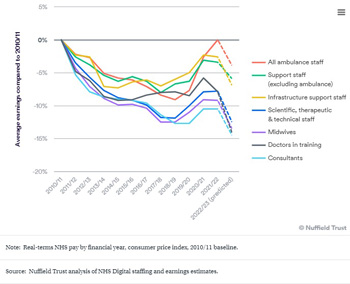
The ambulance service has been under fire for years for poor response times. But anyone can see it is on its knees – and that is at least partly because the rest of the health service is on the floor. People have to wait for an ambulance to arrive because too many of them are queueing up outside hospitals, which don’t have the capacity to admit patients and get the 999 crews back on the road. This is not an effect of ‘hard-left militant unions’. It may be an effect of lack of funds, staff shortages, inadequate social care, poor administration – apportion blame wherever you wish – but the unions didn’t create this situation; their members have to deal with it day in, day out and they have decided they want more money to continue doing so.
How much more money? Who knows? None of the newspapers can tell us. Because the ambulance workers haven’t set a figure. They say the 4% increase they were given earlier this year is not enough when inflation is running at 11%, but that’s all. As with the nurses – who are, according to Rishi Sunak, seeking 19% – the health secretary Steve Barclay is refusing to talk about pay at all. Instead, he is spending his time writing columns for the Mail on Sunday and for the Telegraph yesterday, producing a splash in which he accused the unions of making a ‘conscious decision to inflict harm on patients’. Which is not at all an incendiary thing to say if you want people to carry on working for you in return for a real-terms pay cut.
And to add egg to the pudding, there was his sidekick Will Quince telling people not to do anything ‘dangerous’ in case they hurt themselves and needed taking to A&E. While the Telegraph was faithfully relaying Barclay’s message, Quince stole the limelight in the Times, Sun, Independent and – deliciously – the Daily Star, which translated ‘official government advice’ into ‘Wrap yourselves in cotton wool’.

Define 'excessive'
It may well be that the Government has a strong argument when it says it can’t afford to pay public sector workers more. But it does seem a bit rich for the Mail to describe an unquantified claim as ‘excessive’ when only three months ago, it was protesting about a supposed threat to the ‘triple lock’ that guarantees pensioners an inflation-matching increase. So it’s ok for those who do nothing to have a 10% pay rise, but people who actually go out to work (saving lives and sometimes risking their own in the process) to provide the funds for that increase are out of order in seeking something comparable. And please don’t get me started on (a) whether pensions are a benefit or (b) people who say ‘I’ve worked hard and paid in all my life, it’s my turn to get something back’: (a) of course they are, and (b) it’s not a savings fund, it’s a social contribution. And I write this as a recipient of the state’s largesse.
A more balanced view
Thankfully, other titles – notably the i and FT – have been more assiduous in separating news reporting and opinion. Chris Giles of the FT provided a useful service yesterday in looking at the review bodies that set public sector pay rates – the people whose independence must not be interfered with, according to Mr Barclay. It seems unions are threatening not to engage with them in future because they believe they are not truly independent. The bodies themselves would argue with that, even though their members are appointed by ministers. Giles does raise interesting points in that their remit goes wider than examining the case for more money and whether it can be afforded – the basis for most employer-employee negotiations – to include a requirement to consider what else government departments want to spend their money on and the Government’s 2% inflation target. One economist quoted in the piece says: ‘There is no reason pay review bodies should be fine-tuning wages to affect economy-wide inflation.’ That was the Bank of England’s job. The piece also points out that public workers’ pay rose by 2.7% in the three months to October, compared with 6.9% in the private sector.
These figures don’t paint the full picture. Those private sector pay rises have benefited the lowest and most highly paid disproportionately, so that people in the middle have done less well. But they are still relevant and could do with appearing in more newspapers than they do.
Mirror on the attack
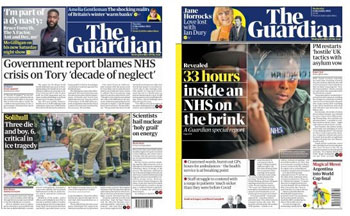
If the Mail, Sun and Telegraph are taking a predictably pro-government, anti-union stance, the Mirror and Guardian are equally predictably doing the opposite. Both have taken the Tories to task – the Guardian for a ‘decade of neglect’ and with a special project on ‘33 hours inside the NHS on the brink’; the Mirror accusing ‘cold-hearted Tories’ of putting lives at risk (two days before Steve Barclay was to accuse unions of deliberately putting patients at risk of harm). The Mirror also came up with a juicy exclusive yesterday of Baroness Mone – she of the PPE scandal – ‘living it up’ in a £6,000-a-night Alpine resort while 999 workers fight for money to pay their bills.
The paper seems to have got its mojo back. It certainly hammered the Tories on Partygate (for which former political editor Pippa Crerar deservedly won a hat-trick of gongs at the British Journalism Awards last Thursday, including the top prize of journalist of the year), but in recent years it has shown a tendency to go AWOL at key moments in the political soap opera.
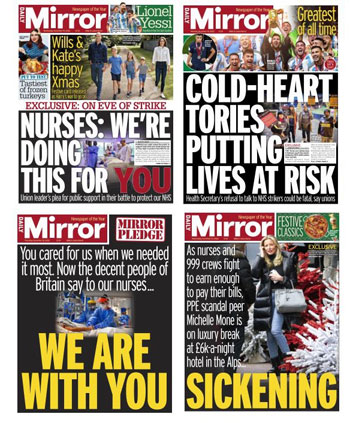
Not this time. It has produced a series of dramatic splashes and spreads on the disputes – with just as much vigour as rightwing rivals. The most powerful was an almost entirely black page, slugged ‘Mirror pledge’ with the splash headline ‘We are with you’. This claimed to speak for ‘the decent people of Britain’. It may well have done so, but, for all its noble sentiment, it was falling into the Sun trap of making itself rather than the nurses the centre of attention. And it’s still ‘attitude’ first, with basic background information again too often missing. Yes, it’s boring to keep publishing the same panels on what’s at issue, but it doesn’t take a lot of space and it would be a start to publish them at least once or twice.
Still, unlike the Sun, at least the Mirror recognises that its readers are not just those inconvenienced or frightened of breaking their legs on a strike day, but also those who are causing that inconvenience and fear.
Express breaks the mould
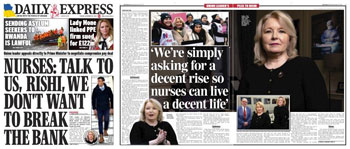
Last word, for now, on this subject is to commend the Express, which broke the Tory press mould on Tuesday with its splash and spread based on an interview with Pat Cullen. Good stuff, well presented.
There are two sides to most stories. Every newspaper is entitled to decide which side it’s on. But most could do better in giving the ‘other’ side a fair hearing. So hats off to the dear old Express for this.
Mystery of the unused bus lane

On the question of airing both sides, I came across a prime example this week, thanks to one of those local news teasers that pop up on your phone from time to time. The gist of it was that a bus gate on a housing estate had been in operation for years, even though the road in question was not and never had been on any bus route. This was set in the context of the county raising millions through fines for bus lane infringements. Seemed interesting, so I clicked. The point had been raised by a 90-year-old woman, who had been moved to speak up after reading about how lucrative those fines were. She was quoted extensively in the piece, which was written by someone bylined as a ‘trainee reporter’.
He had looked into the history of the gate and also recalled the case of a tourist who had successfully challenged a fine elsewhere in the town because of inadequate signage. There was a comment from the highways department at the end saying the gate in question was under review.
A reasonably rounded piece, it seemed. Although the reporter appears not to have asked how much money had been raised in fines from drivers using the bus lane on the road with no buses.
Had he done so, he might have reported that while the road markings, enforcement signs and vehicle recognition cameras had been installed in 2015, the cameras had never been activated (the highways spokesman might also have mentioned this). We learn this from the comment thread that followed. And very interesting it was, from questioning the woman making the complaints to an explanation of why the gate had been included in the planning for the estate – to stop the road becoming a rat run – as well as an extended debate about access to buses, the quality of the service and general traffic calming measures. Someone made the pertinent remark that it was the highways department’s job to make bus lanes available, it was up to bus companies to decide whether to run services that made use of them.
Of course, these commenters were all self-selecting, probably had their particular axes to grind, and may not have had all the facts at their fingertips. But my point is that here was a variety of opinion that drew a bigger picture, whereas the story was based on one woman’s perception of the situation. The reporter didn’t do a bad job. It’s just that it’s always a good thing to seek out more voices. Though when you get them, you need to beware of creating a cacophony that makes no sense to anyone.
Clarkson diatribe breaks Ipso records
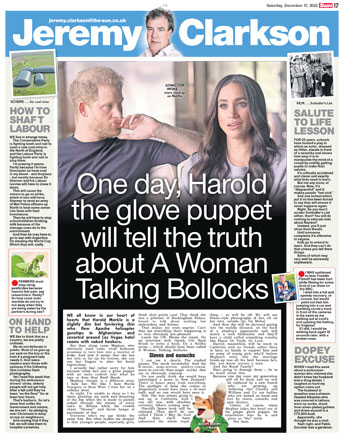
My bedtime reading this past week has been Diddly Squat, a collection of Jeremy Clarkson’s columns about his attempt at what he would call ‘farmering’. We enjoyed the television series and the book arrived in the house as a Christmas present last year. Much in the early chapters is laugh-out-loud funny and the man definitely has a way with words. He is, perhaps surprisingly, anti-Brexit and pro-environment. He looks after bees, mourns the decline of the insect population, makes havens for wildlife, and plants trees.
He is also rude about others who have similar concerns, but choose to address or express them in a different way. People like Greta Thunberg. And even ‘Sir Attenborough’.
He is prone to sweeping generalisations and there’s a chippiness that has always been evident in his writing on other subjects, but which became more apparent in the later stages of the book.
Or maybe I just started to notice it more. Because by the time I reached the last 50 pages, I was having qualms about whether I should be reading it at all.
You won’t hear a Gary Glitter song on the radio any more. Harvey Weinstein films won’t feature in the Christmas TV listings. They are at the thick end of the ‘cancel culture’ wedge. Few question those judgments. But where do we draw the line? The line where someone makes those judgments for us – as above – or where we are left to make them for ourselves?
Choosing not to read someone’s books or listen to their music because you disapprove of their outlook or behaviour beyond their art is one thing. It impinges on no one, other than very slightly reducing the income of the person you’re boycotting.
The toppling of slave-trader statues, the National Trust revisiting the backgrounds of its properties, the no-platforming of Holocaust deniers is quite another. These are the results of people feeling the need to go beyond small personal protests, to make a difference, to atone for others’ mistakes in the past and to demonstrate that certain attitudes are unacceptable now. And it enrages anti-woke crusaders who hate the ‘sanctimonious, virtue-signalling elites’. They cry ‘censorship’, ‘free speech’, and insist on their right to be nasty to whomever they choose. The snowflakes should grow a backbone; sticks and stones and all that. It’s the same mentality as those who say they were beaten at school or had to put on an extra jumper because they didn’t have central heating ‘and it didn’t do me any harm’. Never mind that the world has moved on and just because we accepted unpleasantnesses in the past, doesn’t mean we should do so now.
Jeremy Clarkson is firmly in this camp and now he is back in the eye of the storm, with his latest attack on the Duchess of Sussex. This came in a Sun column last Saturday that described her husband as ‘Harold the glove puppet’ (if he wants to be rude to the Duke by using his full, rather than familiar, name, he might at least have taken the trouble to find out that he was christened Henry, not Harold).
Press reaction
The nastiness of his Meghan fantasy has been well covered and needs no repeating here. What I am interested in is the reporting of it.
First of all, Sun editor Victoria Newton was a guest on Laura Kuenssberg’s Sunday morning TV show, specifically to talk about coverage of Harry and Meghan, yet she was not asked about this column. Had neither Kuenssberg nor her researchers seen it? Or the social media furore it had caused? Hadn’t they done their homework? Or was Newton being given an unforgiveable free pass?
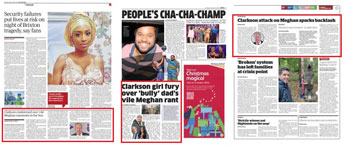
On Monday, Metro, the Telegraph, Star, Guardian and i picked up on the story, reporting that Clarkson’s daughter Emily was among those angered by the column. Others included Nicola Sturgeon (who was lumped together with serial killer Rose West in Clarkson’s list of those he hated), the comedian John Bishop and the actor Kathy Burke. Complaints started to flow to Ipso, including one from Emily Clarkson, who wrote in an Instagram post: ‘My views are and have always been clear when it comes to misogyny, bullying and the treatment of women by the media. I want to make it very clear that I stand against everything that my dad wrote about Meghan Markle and I remain standing in support of those targeted with online hatred.’
Ms C had earlier written a post condemning the Daily Mail for its coverage of the duchess, saying it was ‘hellbent on destroying this woman’.
By lunchtime that day, Clarkson was having regrets and tweeted that his writing had been ‘clumsy’ and that he was ‘horrified’ to have caused so much hurt. This was interpreted by some as an apology, though I would say it came from the Priti Patel ‘I’m sorry that you took offence’, rather than ‘I’m sorry for what I did’ school of regret.
Oh dear. I’ve rather put my foot in it. In a column I wrote about Meghan, I made a clumsy reference to a scene in Game of Thrones and this has gone down badly with a great many people. I’m horrified to have caused so much hurt and I shall be more careful in future.
— Jeremy Clarkson (@JeremyClarkson) December 19, 2022
By the end of the day, Ipso was saying it had received a record 12,800 complaints and it was pretty well impossible for any newspaper to ignore. Those that were already on the case followed up their previous efforts – with the Star splashing on ‘Soz for being such a moron’. The Mirror joined the party with 130 words back on page 21, the Express also thought 21 was the page for its 92 words on Clarkson being horrified, while the Mail ran a basement on page 11, under a page lead headlined, ‘Brace yourselves…H&M have another new series!’
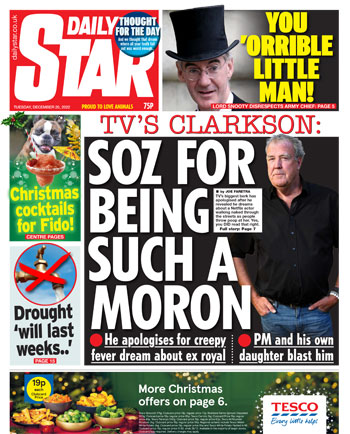
How News UK titles covered it
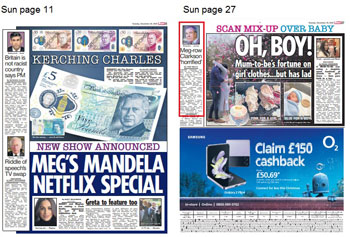
And what about the News UK titles, publishers of the offending article? Both the Sun and the Times carried stories about the Sussexes early in their books. The Times had ‘Duke to promote memoir with interview with Tom Bradby’ on page 11, while the Sun chose the same page for ‘Meg’s Mandela Netflix special’. Both pages were dominated by pictures of the first King Charles bank notes.
So where was Jezza? The Sun put ‘Meg-row Clarkson “horrified”’ on page 27, a 115-word story that was basically a repeat of his tweet with no reference to the avalanche of complaints, merely noting that he had ‘received criticism’. The original heading ‘Clarkson sorry for Meg row’ never made it into print – though it did reach the NLA cuttings library. Whether this proof-stage change was a recognition that he wasn’t really sorry or the Sun’s belief that there was nothing to apologise for, who can say?

Meanwhile, the Times – whose new editor Tony Gallagher used to run the Sun – ran a 63-word filler at the foot of page 12 headlined ‘Clarkson’s Meghan error’. This said there had been 6,000 complaints to Ipso – just half the tally that had been reached long before the paper went to press. This was a standalone filler under the Quintagram puzzle that would probably have found a home in a column of nibs had they not mysteriously been exorcised for the past week. Why it couldn’t have been shoe-horned into the previous page with the rest of the M&H copy is anyone’s guess.
And that, as far as the Sun was concerned, was that. Others have reported that it had taken the column down from its website ‘at Clarkson’s request’ (is that detail to make him look good and repentant or a sign that the paper still doesn’t see anything wrong with it?), but the paper itself has said nothing more. The Times did, however, return to the story yesterday with an update on the complaints numbers – now past 20,000 – at the top of its restored column of page 4 briefs.
No one likes having to report their own failings, but this burying of bad news is pretty much in a league of its own. Especially given the way both titles are wont to run stories about phone lines being jammed and post boxes stuffed with protest letters when a couple of hundred people are unhappy with the BBC.
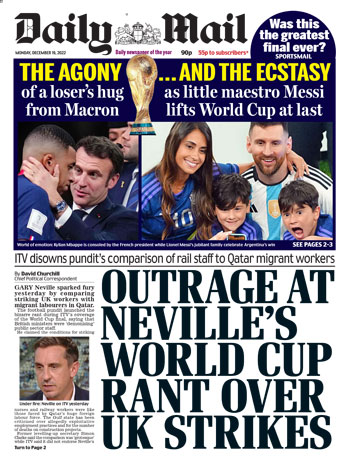
The Mail does too, of course. And on the day that everyone was being outraged by Clarkson’s comments, it was busy splashing on outrage over another TV star’s ‘rant’ : Gary Neville ‘likening’ working conditions in Qatar to those of Britain’s strikers. He had, it said, ‘sparked fury’ and been ‘disowned’ by ITV over his remarks. As is so often the case, the fury was voiced by the Mail’s go-to cross people: Tory MPs Iain Duncan Smith, Simon Clarke and Lee Anderson, plus Theresa May’s former adviser Nick Timothy. ITV hadn’t disowned Neville. It said he was expressing his own opinions, which hadn’t been endorsed by the network. It’s not the same thing.
By the way, it doesn’t matter how many thousands of people complain to Ipso, the chances of it finding against Clarkson are remote. There is nothing in the Editors’ Code to stop writers being offensive and it would be hard to argue that his nastiness was discriminatory – especially since he was equally offensive to Nicola Sturgeon.
If Ipso does reject the complaints, there will be an outcry about how lily-livered and ineffective it is, just as there was after the Katie Hopkins ‘cockroaches’ column was cleared because the code on discrimination protects only individuals, not groups.
So what’s the point in complaining? Well, after the cockroaches thing, Hopkins was deemed too toxic and soon lost her column in the Sun (as Kelvin MacKenzie did after likening a footballer to a gorilla). She moved to Mail Online and was soon deemed too poisonous for them, too.
Clarkson has already been fired by the BBC for his attitude to production staff; he is unlikely to lose his News UK columns over this one paragraph (after all, the whole of Fleet Street seems to regard Meghan as fair game). But ITV may be thinking about whether someone else might present Who Wants to be a Millionaire?
And if Ipso does clear Clarkson, it might like to consider how it might tweak its code to encompass the most egregious material (which may still not include that column) that doesn’t fit into any of its current categories. It’s a very thin line to tread, balancing free speech against hate speech. But it should be possible to get something in the code about incitement to calm the rhetoric just a smidge.
Colour co-ordinated?
I am too old and so have too little life left to spend much more of it contemplating the way our Press treat the Sussexes (and vice versa). No one needs me to tell them that it’s been a feeding frenzy this past two weeks. But I would note two things:
First:
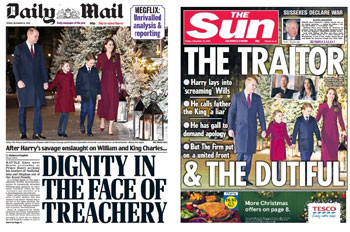
Even before I saw the page itself, I knew the Mail headline ‘Dignity in the face of treachery’ would relate to a photograph of Kate being Kate. In fact, it was almost the whole Cambridge clan (who are now, of course, the Waleses), heading off to do something virtuous. Treachery seemed a bit strong. Then I saw the Sun. It was drawing the same comparison, but went further in its headline writing: ‘The traitor and the dutiful’.
These are our two best-selling newspapers. Their business is words. They use them for impact. Of course they do. Words may just be scraps of type on a piece of paper, but they can be powerful and dangerous. The Jeremy Clarkson fallout included reminders of the way his sort of language can lead to physical abuse and actually put women at risk. I’m not suggesting that people are going to attack Harry and Meghan physically because a couple of tabloids call them traitors. They have security – even if the King isn’t willing to pay for it. But we are in perilous territory.
Second:
Charlotte and Kate were back at the top of the Mail front page yesterday with the teaser ‘Was the great royal burgundy parade a cheeky swipe at Meghan?’ Oh, for heaven’s sake! I thought. Can’t you just let it rest?

But the Mail was obviously pleased with its property because it ran with the theory across pages 2 and 3, with a QR code so readers could join in a poll on whether they agreed. I couldn’t resist. And do you know, I think they may have had a point. It wasn’t just Kate and Charlotte who turned out for their carol service in burgundy, their whole entourage did, including Zara Phillips and Pippa Middleton, while the men all had co-ordinating ties. There can be no doubt there was an orchestrated dress code. Whether it was a giant raspberry in Meghan’s direction, we can’t be sure, but she did say in her Netflix documentary that she was told that senior royals always took care never to wear the same colour as each other at the same event.
She also said that to deal with this issue, she tended to wear white or muted tones because other royals didn’t. But Amanda Platell notes in her sleuthery that the Queen Consort and the Duchess of Wessex both wore white to the carol service. Were they in on the joke or just coincidence?
It’s all inconsequential, unsubstantiated flim-flam. But it is beautifully constructed flim-flam.
And so this is Christmas, and what have you done?
As John Lennon wrote 50 years ago, it is time to reflect and look forward (though of course war isn’t over). Christmas Eve falling on a Saturday is great news for the supplement editors, making perfect timing for the quizzes and the retrospectives, and the same again next weekend for the ‘what to look out for in 2023’.
These are perfect space gobblers for a quiet patch when there are fewer authors and film stars putting themselves up for interview to promote their latest efforts. We can expect the ‘Year in pictures’, the ‘Year in cartoons’, and reminders of ‘Those we lost in 2022’. I love these obituary collections – there’s always a name in there that makes you go ‘I didn’t realise they’d died’ – but am always dubious about that particular phrase. It implies affection and sorrow, but it makes it about us, not the person who has died.
The trouble with these staples is that they are almost inevitably formulaic. Essentially there are two choices: a calendar or an alphabet. Those opting for the latter have an easier time this year, thanks to presidents Xi and Zelensky, and they’re spoilt for choice on Q with the Queen, the Queue and Qatar.
Two mags jumped the gun last week – the Telegraph devoted most of theirs to the A-Z of 2022, with its theatre billboard-style cover, ‘Three prime ministers, two monarchs and one hell of a heatwave’. It’s been quite the year.
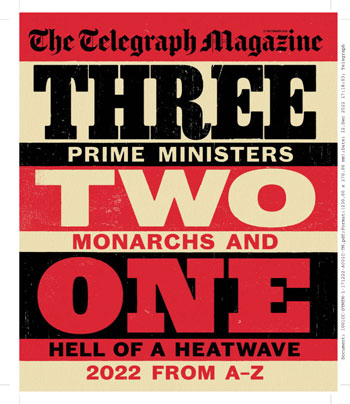
The Times took the other route, but rather buried its gem: Hugo Rifkind telling the story of the year in a variety of voices, as he does in the main book every Saturday with his ‘My Week’ column. This occupied half a dozen pages early in the magazine but merited only a small puff on the cover, which saw Liz Hurley talking about her dead men as its main selling point.

I have to say, this was pure joy. Go back and find it and read it. Hugo has set the bar high for those following this weekend. Can’t wait to see if the Guardian, with its great font of wit, can measure up.
Front page of the fortnight
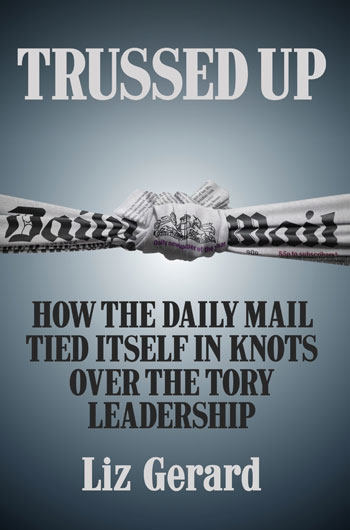
A piece of shameless self-promotion! You may remember that back in October, we ran a Notebook special on the way the Mail had covered the Tory leadership campaign and its fallout, from the day Boris Johnson left office to the day Rishi Sunak moved into No 10. (I noted at the end that the paper that had done its best to keep Sunak out would henceforth be urging everyone to back him and, lo and behold, it is already securing interviews with its new hero and splashing on how he will not back down over the strikes.) Anyway, that project has now been published as a book, which I obviously urge you to buy. You can do so here.
But seriously…
The Mirror has been on song this past couple of weeks. This was my favourite:
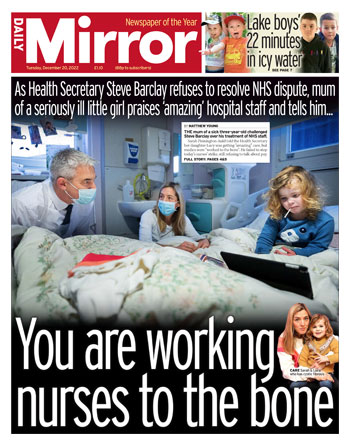
Happy Christmas everyone, and good luck for 2023.
Liz Gerard’s Notebook is a fortnightly column published in the InPubWeekly newsletter. To be added to the mailing list, enter your email address here.












